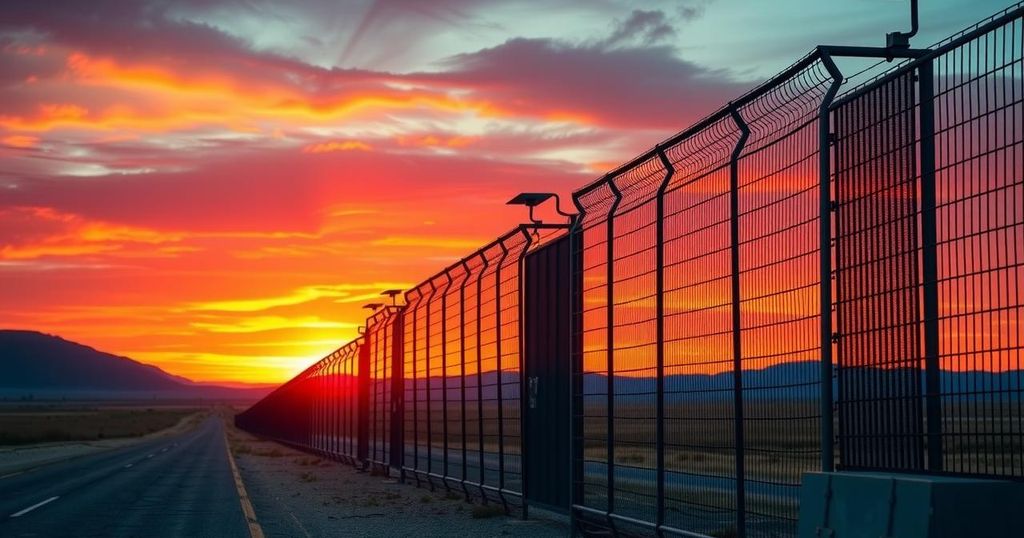World news
2024 PRESIDENTIAL ELECTION, ADAM ISACSON, AMERICA, ASIA, CONGRESS, CUSTOMS, DONALD TRUMP, HOMELAND SECURITY, HOUSE, HOUSE HOMELAND SECURITY COMMITTEE, IMMIGRATION, IMMIGRATION AND CUSTOMS ENFORCEMENT, LA, LEGISLATION, LOS ANGELES, MEXICO, MIKE JOHNSON, NORTH AMERICA, PHILIPPINES, POLITICS, SENATE, TRUMP, TRUMP ADMINISTRATION, U. S, U.S. ELECTIONS, UNITED STATES, WOLA
Stella Nguyen
0 Comments
Four Ways Trump’s Big Bill Could Change the U.S. Immigration System
President Trump’s immigration bill proposes $150 billion to enhance border security, increase detention capacity, and modify immigration court funding. While it prioritizes law enforcement and construction of barriers, the specifics and impacts of these measures remain unclear. Substantial fee increases could affect many seeking legal immigration, raising concerns about the accessibility of such processes.
In a significant move, President Donald Trump’s proposed border security and spending cuts bill aims to inject approximately $150 billion into his immigration enforcement agenda over the next four years. This funding is intended for various initiatives, including the construction of the southern border wall and the expansion of detention centers. What’s evident is that this hefty financial package may transform the U.S. immigration system by widening the law enforcement and detention framework while also raising costs for legal immigration.
As it stands, the annual budget for Immigration and Customs Enforcement (ICE), the principal department for immigration enforcement, is around $10 billion. With the passage of this proposed bill, which the Senate is currently debating—largely echoing the House’s stance—Republicans emphasize the urgency of the legislation amidst objections from Democrats. Protests in places like Los Angeles earlier this month have been leveraged by GOP leaders to advocate for swift passage.
House Speaker Mike Johnson recently declared, “The lawlessness happening in LA is ANOTHER reason why we need to pass the One Big Beautiful Bill IMMEDIATELY. It provides the ESSENTIAL funding needed to secure our nation’s borders.” However, the ambiguity of the bill raises questions about its practical implications and applications. Adam Isacson from WOLA noted the vague language in the bill, stating, “One thing about this bill, these sections are super vague. There’s no real specificity in the bill about how it’s going to be spent.”
The bill allocates a staggering $46.5 billion for what is termed an “integrated border barrier system,” which encompasses fencing, water barriers, law enforcement access roads, and advanced technologies. The proposed objectives include completing an extensive 701 miles of primary walls and an additional 900 miles of river barriers along the U.S.-Mexico border, marking a substantial financial commitment.
Chairman of the House Homeland Security Committee, Rep. Mark Green of Tennessee, emphasized that lawmakers must show accountability regarding border security with their efforts. However, the actual effectiveness of such barriers continues to be a contentious topic. While illegal border crossings have decreased under the current administration’s policies, concerns remain about how these trends may shift.
The legislation further earmarks $45 billion to broaden the immigrant detention network and enhance staffing, addressing the growing needs amidst rising immigration enforcement. However, the implementation specifics regarding conditions within detention facilities are left up to the Secretary of Homeland Security, which raises additional concerns about standards and practices.
ICE aims to boost its current detention capacity from roughly 41,000 to 100,000. The agency’s acting director has indicated a keen interest in creating a deportation system that mirrors rapid delivery models akin to Amazon, which might not materialize with the requested funding alone. Shares of private prison companies such as Geo Group Inc. and CoreCivic have surged since Trump’s election, hinting at potential benefits for that sector.
Moreover, the proposed bill allocates $1.25 billion for the immigration court system, introducing funding for more judges and judicial support. While this funding is seen as urgently needed—given the backlog exceeds 3.6 million cases—the effectiveness of this investment in resolving systemic issues remains to be seen. Experts believe the rising incidences of arrests surrounding immigration courts might signal a policy shift aimed at circumventing court procedures altogether.
Lastly, the bill proposes significant fee increases for various immigration processes. For example, the asylum application fee would be raised to $1,000, with additional costs for employment applications and appeals. While wealthier immigrants may find these adjustments manageable, for many, even minor fees could deter their immigration plans altogether. The impact of these proposals is still unfolding, bringing light to the complex and often contentious landscape of immigration policy in the U.S.
In summary, President Trump’s proposed bill represents an extensive overhaul of the U.S. immigration system, aiming to funnel substantial funds into border security, immigration enforcement, and court processing. While the rhetoric surrounding border safety continues, the bill’s vague provisions raise questions about practicality and implementation. The proposed increases in immigration costs could significantly deter many from pursuing legal immigration pathways. As Congress debates this considerable legislation, its future remains uncertain amidst the ongoing political turbulence.
Original Source: www.pbs.org




Post Comment